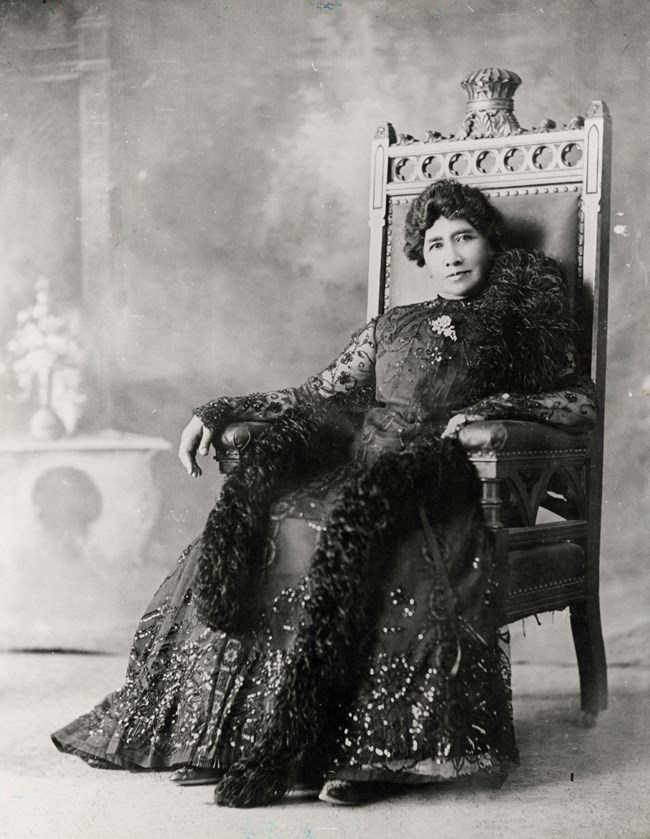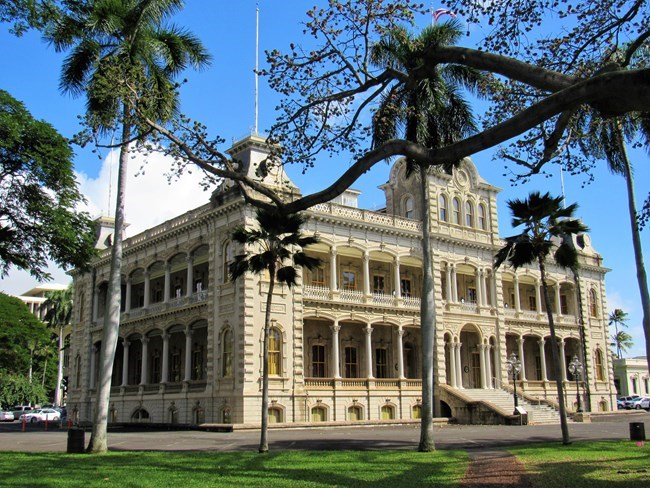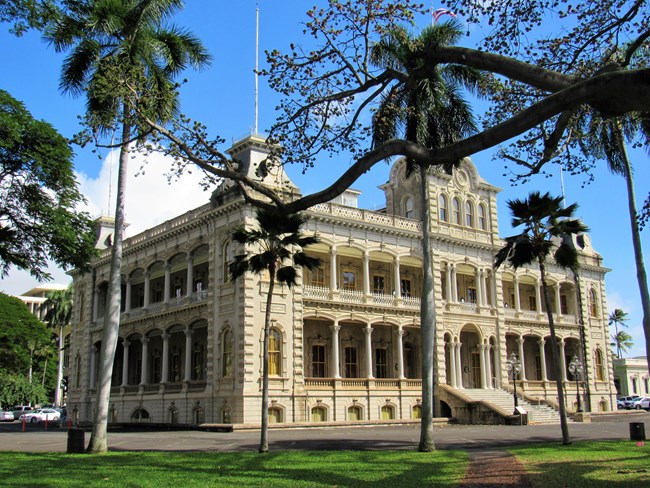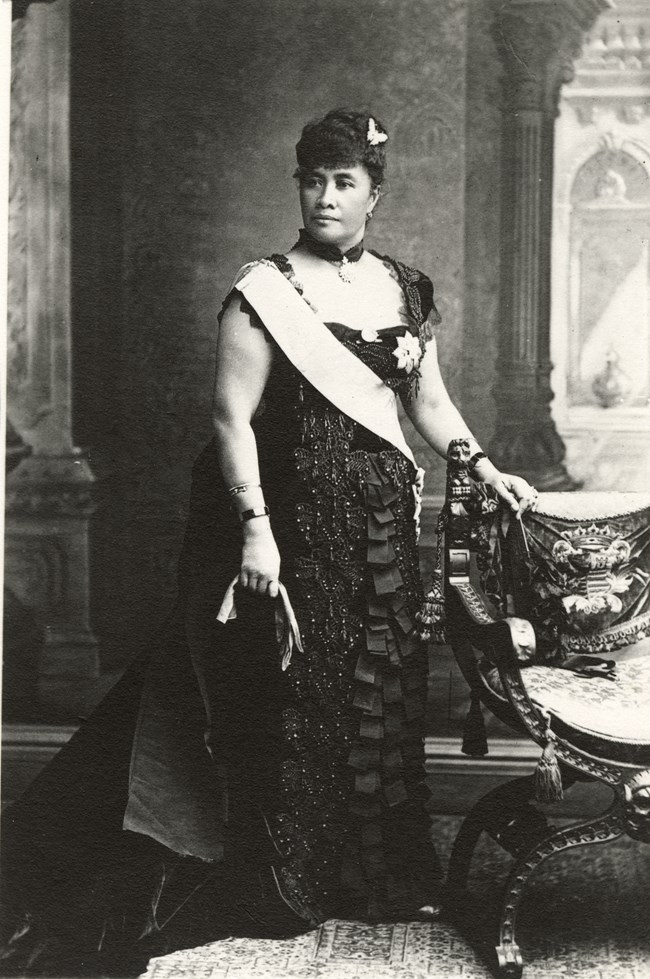Part of a series of articles titled Women's History to Teach Year-Round.
Article
(H)our History Lesson: Liliuokalani, Hawaii's Last Queen

Introduction
"Women's History to Teach Year-Round" provides manageable, interesting lessons that showcase women’s stories behind important historic sites. In this lesson, students explore the life of Hawaiian Queen Liliuokalani and her tireless advocacy for Hawaiian sovereignty from Iolani Palace in Honolulu, Hawaii.
This lesson was adapted by Talia Brenner and Katie McCarthy from the Teaching with Historic Places lesson plan, “Iolani Palace: A Hawaiian Place of History, Power, and Prestige." If you're interested in more information and activities on this topic, explore the full lesson plan.
Grade Level Adapted For:
This lesson is intended for middle school learners, but can easily be adapted for use by learners of all ages.
Lesson Objectives:
Learners will be able to...
-
Identify the ways in which U.S. Imperialism affected the people and landscapes of foreign territories.
-
Describe the ways in which European and American imperialism affected the Hawaiian Islands.
-
Identify aspects of a text that reveal an author’s point of view or purpose
-
Determine the central ideas or information of a primary or secondary source.
-
Cite specific textual evidence to support analysis of primary and secondary sources.

Inquiry Question:
King Kalākaua rebuilt the royal Iolani Palace to contain both European and Hawaiian features. How does the way this building looks tell us about who lived there and what they valued? What kind of message did King Kalākaua hope to send with its architecture? Why was this message important?
Background
Native Hawaiians are part of the Polynesian people who live throughout the South Pacific region. The first Hawaiians arrived more than one thousand years ago, travelling extremely long distances in canoes from either Tahiti or the Marquesas Islands. Traditionally, Hawaiians were governed by patchwork of localized governments. King Kamehameha I later united the smaller Hawaiian Islands under a single government, creating the Hawaiian monarchy.
The first Europeans on record arrived in 1778. As white Christian businessmen and missionaries established permanent residences on the islands, contact between Hawaiians and foreigners became more frequent. Colonizers introducted deadly diseases like smallpox, measles, and tuberculosis, resulting in devestatingly high death tolls among the Hawaiian people. As increasing numbers of Europeans and Americans reached Hawaii, their governments became interested in profiting on Hawaii’s natural resources.

Reading
Liliuokalani was born in 1838. She was the daughter of a powerful Hawaiian family. In her youth, she socialized with the royal family and other influential Hawaiians. Liliuokalani was a talented musician and composer from childhood. “To compose was as natural to me as to breathe,” she later wrote.1
During Liliuokalani's early life, foreign businessmen from Europe and the United States strengthened their hold on Hawaii. In the mid-1800s, the Monarchy established private land ownership and allowed foreign citizens to own land. This allowed foreign businessmen to form large sugar plantations, mills, and shipping companies. Chinese and Japanese migrant laborers worked on the plantations. By the late 1800s, foreign landowners, primarily from the United States, had acquired large portions of Hawaii.
Hawaiians began to follow more European customs. Christianity became established in the islands. Liliuokalani was baptized with an English first name, Lydia, and attended a Christian boarding school. “Our instructors were especially particular to teach us the proper use of the English language,” she later remembered.2 She married John Dominis, a white American. They later adopted three children. When King Kamehameha V died in 1874 without a successor, the government elected a new king: David Kalākaua, Liliuokalani’s brother.3
As a princess, Liliuokalani met with foreign dignitaries and worked for charitable organizations. Her greatest passion appears to have been the Liliuokalani Educational Society, which provided schooling for impoverished Hawaiian girls.4 During King Kalākaua’s reign, a small but powerful group of European and American landowners began to plot against the Hawaiian monarchy. They wanted more political power in order to change Hawaiian laws to help their businesses. In 1887, a group of white foreigners known as the Hawaiian League attempted a coup (a violent overthrow of the government). Liliuokalani was shocked by the Hawaiian League’s “ingratitude” toward the King.5
“This rebellion against constituted authority had been brought about by the very persons for whose prosperity His Majesty Kalakaua had made such exertions, and by those to whom he had shown the greatest favors,” she wrote.6
The Hawaiian League forced King Kalākaua to sign a new constitution that gave foreign landowners more power in Hawaii. This document was known as the “Bayonet Constitution.”

King Kalākaua died in 1891 and Liliuokalani became Queen. As Queen Liliuokalani, she was determined to restore power to the weakened Hawaiian monarchy.7 Indigenous Hawaiians overwhelmingly supported her. Many had voted in elections under the monarchy and wanted to protect those democratic processes from a small group of white foreigners. Yet as import rates on sugar from Hawaii increased, politicians in the United States began to more seriously consider overthrowing the Hawaiian government.8 If they could make the islands part of the United States, it would be easier for American companies to import Hawaiian goods.
In 1893, a group of foreign landowners conspired with the United States Marines to stage another coup against the Hawaiian monarchy. The Hawaiian League removed all of the queen’s powers and installed a government made up of white Americans. Liliuokalani continued to advocate for the Indigenous Hawaiian government, arguing that she was the legitimate leader of Hawaii. Her mental health suffered under the “terrible strain” of an unknown future.9
In 1895, a group of Liliuokalani’s supporters led an armed revolt in an attempt to restore the monarchy. Liliuokalani reported in her memoir that she was aware of the plan but not involved with it.10 Regardless, the colonial government blamed her and put her on trial for treason in Iolani Palace.11 Liliuokalani was convicted and imprisoned in her bedroom.12 She later wrote, “that first night of my imprisonment was the longest night I have ever passed in my life."13 While in prison, Liliuokalani surrendered her claim to the throne in exchange for pardons for the revolt leaders. She believed that the revolt leaders would have been executed.14 Liliuokalani was later transferred to house arrest in a different building.
The white landowners who now ruled Hawaii wanted to join the United States, but President Grover Cleveland denied their offer. When William McKinley became president in 1897, he supported annexing Hawaii. Liliuokalani, now out of prison, led Indigenous Hawaiians in opposing the annexation treaty. The former Queen wrote letters to American politicians and organized petitions. In September 1897, more than half of all Hawaiians signed petitions against the treaty. More than half of the signers were women. That same year, Liliuokalani led a group of activists to Washington, D.C., where they presented their petitions to the U.S. Senate.
Americans were divided on the issue of Hawaii. Some wanted an overseas empire, like that of England or France. Others argued that empires were unjust. Despite Liliuokalani’s eloquence and persistence, U.S. financial and military interests were more powerful. In 1898, the United States annexed Hawaii. The United States took control of the Philippines, Guam, and Puerto Rico all in that same year. Over time, Hawaiians became Americans. The United States made Hawaii a state in 1959. Many Indigenous Hawaiians today still protest the United States’ colonization of their islands. Liliuokalani spent the rest of her life advocating for Hawaiian sovereignty, even suing the United States. When she died in 1917 at the age of 79, she was buried as Hawaiian royalty.
Discussion Questions
-
Who were the foreign landowners in Hawaii? Where were they from? Why did many of them want to overthrow the Hawaiian government?
-
How do you think the “Bayonet Constitution” got its name?
-
Why did Liliuokalani agree to officially resign her claim to the throne? How do you think she felt in this moment?
-
Why did Indigenous Hawaiians oppose the United States’ decision to annex Hawaii, since the Hawaiian monarchy had already been overthrown?
-
Why do you think some Americans did not want to annex Hawaii?
1 Liliuokalani, Hawaii’s Story by Hawaii’s Queen (Boston: Lee and Shepard, 1898), http://digital.library.upenn.edu/women/liliuokalani/hawaii/hawaii.html.
2 Liliuokalani, Hawaii’s Story by Hawaii’s Queen.3 “Five Things To Know About Liliʻuokalani, the Last Queen of Hawai'i," Smithsonian Magazine, 10 November 2017, https://www.smithsonianmag.com/smart-news/five-things-know-about-liliuokalani-last-queen-hawaii-180967155/.
4 Liliuokalani, Hawaii’s Story by Hawaii’s Queen.
5 Liliuokalani, Hawaii’s Story by Hawaii’s Queen.
6 Liliuokalani, Hawaii’s Story by Hawaii’s Queen.
7 “Queen’s Imprisonment,” Iolani Palace, https://www.iolanipalace.org/history/queens-imprisonment/.
8 "Did You Know: Queen Liliuokalani," National Park Serivce, https://www.nps.gov/articles/did-you-know-queen-liliuokalani.htm
9 Liliuokalani, Hawaii’s Story by Hawaii’s Queen.
10 Liliuokalani, Hawaii’s Story by Hawaii’s Queen.
11 “Queen’s Imprisonment,” Iolani Palace, https://www.iolanipalace.org/history/queens-imprisonment/.
12 “Queen’s Imprisonment.”
13 Liliuokalani, Hawaii’s Story by Hawaii’s Queen.
14 Liliuokalani, Hawaii’s Story by Hawaii’s Queen.
Activity:
Liliuokalani’s Musical Legacy
Distribute the lyrics of the following three songs. Then, play recordings of each (all freely available online). After each song, students should answer the questions that follow, working either individually or in small groups. After students have completed the questions for all three songs, present them with the following prompts: What is Liliuokalani’s legacy? How does the song “Hawai’i ‘78” show Liliuokalani’s legacy? Students could respond to this question either in a discussion or a written response.
Aloha ‘Oe
Queen Liliuokalani wrote this song in 1878, years before the coups that removed her from power. It later became popular as a national song. “Aloha ‘Oe” lyrics and translation are available at the Huapala Hawaiian Music and Hula Archives.
|
Haʻaheo ka ua i nā pali |
Proudly swept the rain by the cliffs |
Questions for “Aloha ‘Oe”
- What do you think this song was initially about?
- Why do you think this song became a popular national song?
He Mele Lāhui Hawaiʻi
Queen Liliuokalani wrote this song before she was queen, at the request of King Kamehameha V. It replaced the British national anthem “God save the Queen” as the Hawaiian national anthem. Hawaii’s national anthem later became “Hawai’i Pono’i,” which is still in use as Hawaii’s state song. “Mele Lāhui Hawaiʻi” lyrics and translation are available at the Huapala Hawaiian Music and Hula Archives.
|
Ka Makua mana loa |
Almighty Father bend thine ear |
Questions for “He Mele Lāhui Hawaiʻi”
- How does this song show the influence of Christianity in Hawaii in the late 1800s?
- According to the lyrics, what is the responsibility of the Hawaiian monarch?
Hawaiʻi ‘78
This more recent song is by Israel Kamawawiwo’ole, a native Hawaiian musician who is most famous for his ukulele cover of “Somewhere Over the Rainbow.” “Hawaiʻi ‘78” lyrics and translation are available at Genius and elsewhere on the Internet.
Ua mau, ke ea o ka aina, i ka pono, o Hawaiʻi (The life of the land is perpetuated in righteousness)
Ua mau, ke ea o ka aina, i ka pono, o Hawaiʻi
If just for a day our king and queen
Would visit all these islands and saw everything
How would they feel about the changes of our land
Could you just imagine if they were around
And saw highways on their sacred grounds
How would they feel about this modern city life
Tears would come from each others’ eyes
As they would stop to realize
That our people are in great great danger now
How, would they feel, could their smiles be content, then cry
Cry for the gods, cry for the people
Cry for the land that was taken away
And then yet you'll find, Hawaiʻi
Could you just imagine they came back
And saw traffic lights and railroad tracks
How would they feel about this modern city life
Tears would come from each others’ eyes
As they would stop to realize
That our land is in great great danger now
All the fighting that the king had done
To conquer all these islands now these condominiums
How would he feel if he saw Hawaiʻi nei
How, would he feel, would his smile be content, then cry
Ua mau, ke ea o ka aina, i ka pono, o Hawaiʻi
Ua mau, ke ea o ka aina, i ka pono, o Hawaiʻi
Questions for “Hawaiʻi ‘78”
- According to the lyrics, what is Kamawawiwo’ole protesting?
- What does Kamawawiwo’ole say about the king and queen?
- Who do you think the king and queen represent in this song?
Wrap-up:
-
How do you think Liliuokalani felt at different points in her life? What is a time when you felt like that?
-
During her life, what do you think Liliuokalani knew about the United States? What might she have cared about?
-
What kind of legacy did Liliuokalani leave in Hawaii? Can you think of a historic person who has had an important impact in your community?
-
What questions do you have after this lesson?
Additional Resources:
The National Park Service
The National Register of Historic Places lists Iolani Palace. Useful information can also be found in the NRHP documentation for the Hawaii Capital Historic District. These records describe the physical palace site and its surroundings as well as their historical significance. The Palace is also featured in the NPS travel itinerary, Places of Asian American and Pacific Islander Heritage.
Library of Congress
The Library of Congress maintains state-specific exhibits of primary sources for the benefit of teachers and students. The Hawaii collection highlights interesting photographs, documents, and other media related to Hawaiian history.
The Park Service's Historic American Buildings Survey documented Iolani Palace in 1984. The Library of Congress hosts this documentation on its website, along with architectural drawings and historic photographs.
Last updated: April 21, 2023
